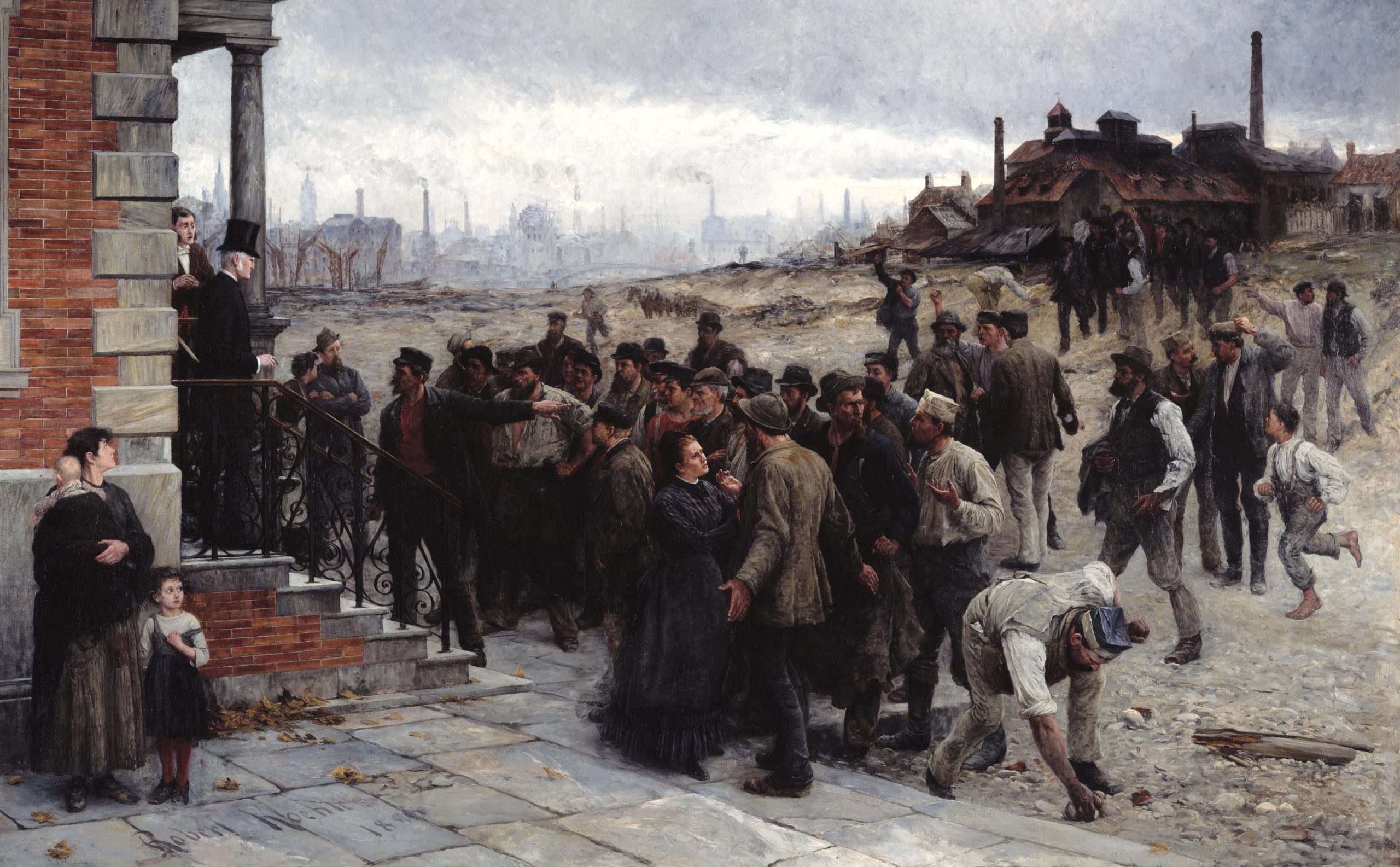In a garbled X exchange in mid-August, former President Donald Trump applauded the strike-breaking efforts of technocrat Elon Musk. In a swift response to the video, the United Auto Workers (UAW) filed federal labor charges against both the Trump campaign and Tesla. And just this week, videos of Republican vice presidential nominee JD Vance getting booed by a Boston firefighter union flooded social media, continuing the wave of disdain for the Ohio senator. Such events point to the undeniable fact that organized labor is in the spotlight, with images and media coverage of ardent unionizers increasing the public’s support. With the number of major work stoppages going up 43% last year, some dubbed 2023 the “year of the strike.” But what is the history of withholding labor, and what role have artisans and artists played in it?
The term “strike” was only coined in 1768 to describe the actions of frustrated British sailors striking the topsails of docked ships. But the history of using work stoppages as leverage to receive better working terms is much older — as are the tactics of bosses, owners, and political leaders in the effort to foil workers’ demands. The oldest known strike occurred in the artisan village of Deir el-Medina around 1157 BCE, during the reign of the pharaoh Rameses III. A scribe named Amennakht recorded on various ostraca and a document called the “Turin Strike Papyrus” that these workers were being paid in wheat increasingly late. Thus, he wrote, the artisans declared they were hungry and left their state jobs as royal tomb builders. As Egyptologist Jenny Cromwell noted in a 2022 blog post, “Descending down the mountain, they spent the day in peaceful protest sat behind the temple of Thutmosis III while government officials came out and shouted at them to return.” Such work stoppages became an effective tool used during the rest of the 20th dynasty, even occasionally relied upon in the subsequent periods of Ptolemaic and Roman Egypt.
Workers in other regions of the ancient world also leveraged strikes far earlier than the famed British sailors who gave the act its modern, English name. As I argue in my forthcoming book, Strike: Labor, Unions, and Resistance in the Roman Empire, work cessations, boycotts, and labor protests were popular in the Roman Mediterranean in particular. Beginning in the 5th century BCE, Romans who were relied on for military service — called plebeians — often refused military drafts by the more elite patricians who monopolized the government. Over the course of almost 250 years during the Struggle of the Orders, plebeians seceded from the city of Rome to avoid serving in the Roman army and thus leveraged their numbers for more political representation and rights.
Later, during the period of the Roman Empire, groups of bakers in places like Ephesus in modern-day Turkey withheld bread during the 2nd century CE. In other instances, pantomimes refused to act with a higher wage, farmers in North Africa threatened to leave their agricultural estates, and charioteer factions incited riots rather than race — all to collectively bargain for better pay and treatment. The injustices exacted upon the plebeians, which then compelled their boycotts and secessions, were later commemorated by Neoclassical artists, such as the French painter Guillaume Guillon Lethière.

But in the United States, it wasn’t until the late 19th century Industrial Revolution that depictions of modern strikes began to take off. According to historian Christopher Phelps, the first painting of a strike ever displayed in the United States is Robert Koehler’s 1886 “Der Streik” (“The Strike”). Koehler created the painting in Munich before presenting it to the spring exhibition of the National Academy of Design in New York City, where it caused an uproar with its imagined scene of factory workers uniting against an employer sporting a top hat. Koehler was well aware of workers’ movements on both sides of the Atlantic: He was born in Germany but moved to Milwaukee where he studied art being created in Pittsburgh and New York, two hubs of the burgeoning labor movement. The artist’s exhibition of “Der Streik” happened at the same time as American workers’ demands for an eight-hour workday, which compelled 350,000 workers across the country to strike and rise up on May 1, 1886 — now celebrated annually as May Day. The painting was well timed to encourage these workers forward in their efforts. Only days later, the Chicago Haymarket affair occurred, with union workers fighting for the eight-hour workweek.
Artistic depictions of strikes have continued to inspire workers, unions, and labor organizers well into the 20th and now 21st centuries. But as American Studies professor Carol Quirke has argued, it is photography and then newsreels that truly changed the worker landscape in pivotal ways. She writes that news photography constituted a “workers’ revolution in the nation’s economic, political, and cultural landscape.” Newspaper photographers could now quickly publish images from strikes and, importantly, could also document police brutality. These images channeled a new capacity to speak directly to the public and underscore injustice, particularly with the advent of newsreels.
Reflecting on the history of strikes this Labor Day, we seem to be witnessing a similar wave of media influence on the resurgence of strike and labor protests. These labor movements are similarly dependent upon the artists documenting and participating in them — from TikToks to photos and zines. Whether in the artisan villages of Ancient Egypt or in front of New York’s Guggenheim Museum as workers rallied for fair contracts in April, visual culture has recorded one constant truth: artists have always been on the picket line.


